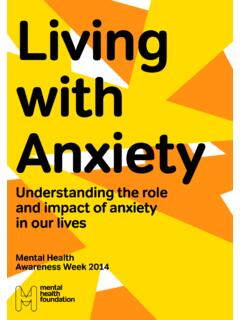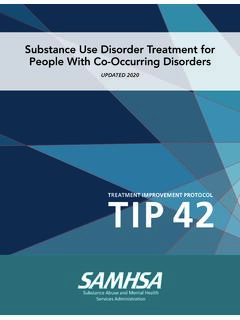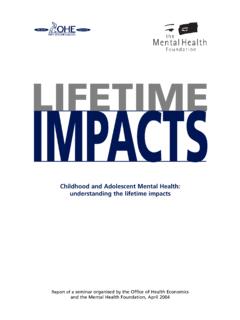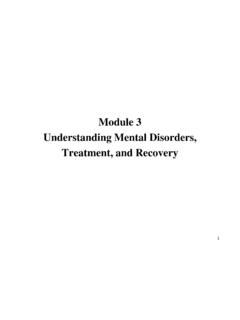Transcription of Understanding Thimerosal, Mercury, and Vaccine Safety
1 Understanding Thimerosal, Mercury, and Vaccine Safety For more information on vaccines, Vaccine -preventable diseases, and Vaccine Safety : Last reviewed Februar y 2013 Thimerosal is a mercur y-containing compound that prevents the growth of dangerous bacteria and fungus. It is used as a preservative for flu vaccines in multi-dose vials, to keep the Vaccine free from contamination. Thimerosal is also used during the manufacturing process for some vaccines to prevent the growth of microbes. In 1999, as a precautionar y measure, the Public Health Ser vice recommended removing thimerosal as a preservative from vaccines to reduce mercury exposure among infants as much as possible. Today, except for some flu vaccines in multi-dose vials, no recommended childhood vaccines contain thimerosal as a preservative. In all other recommended childhood vaccines, no thimerosal is present, or the amount of thimerosal is close to zero.
2 No reputable scientific studies have found an association between thimerosal in vaccines and autism. There are two different compounds that contain mercury: ethylmercur y and methylmercury. The low levels of ethylmercury in vaccines are broken down by the body differently and clear out of the blood more quickly than methylmercury. | questions and answers | What is thimerosal? Is it the same as mercury? Thimerosal is a compound that contains mercury. Mercury is a metal found naturally in the environment. Why is thimerosal used in some vaccines? Because it prevents the growth of dangerous microbes, thimerosal is used as a preservative in multi-dose vials of flu vaccines, and in two other childhood vaccines, it is used in the manufacturing process. When each new needle is inserted into the multi-dose vial, it is possible for microbes to get into the vial. The preservative, thimerosal, prevents contamination in the multi-dose vial when individual doses are drawn from it.
3 Receiving a Vaccine contaminated with bacteria can be deadly. For two childhood vaccines, thimerosal is used to prevent the growth of microbes during the manufacturing process. When thimerosal is used this way, it is removed later in the process. Only trace (very tiny) amounts remain. The only childhood vaccines today that have trace amounts of thimerosal are one DTaP and one DTaP-Hib combination Vaccine . Why was thimerosal removed from vaccines given to children? In 1999, the Food and Drug Administration (FDA) was required by law to assess the amount of mercury in all the products the agency oversees, not just vaccines. The Public Health Service decided that as much mercury as possible should be removed from vaccines, and thimerosal was the only source of mercury in vaccines. Even June 30, 1999 Food and Drug Administration (FDA) announces results of its review of total amount of ethylmercury from thimerosal preservative in childhood vaccines.
4 July 9, 1999 Public Health Service (PHS) and American Academy of Pediatrics (AAP) recommend removing thimerosal as a preservative from childhood vaccines as a precautionary measure. 1999 Manufacturers begin to phase out use of thimerosal as a preservative in childhood vaccines. 2001 Manufacturing of childhood vaccines with thimerosal as a preservative ceases. 2003 All childhood vaccines with thimerosal as a preservative have passed their expiration date and are no longer available in the The amount of mercury in vaccines recommended for children is close to zero. 2004 Influenza vaccination recommended for children ages 6 through 23 months old. Thimerosal is used as a preservative in multi-dose vials to prevent contamination of the vial when individual Vaccine doses are drawn from it. Single-dose vials without thimerosal are available. 2008 Influenza vaccination recommended for all children ages 6 months through 18 years.
5 231405C | questions and answers | continued though there was no evidence that thimerosal in vaccines was dangerous, the decision to remove it was a made as a precautionary measure to decrease overall exposure to mercury among young infants. This decision was possible because childhood vaccines could be reformulated to leave out thimerosal without threatening their Safety , effectiveness, and purity. Today, no childhood Vaccine used in the except some formulations of flu Vaccine in multi-dose vials use thimerosal as a preservative. Why is thimerosal still in some flu vaccines that children may receive? To produce enough flu Vaccine for the entire country, some of it must be put into multi-dose vials. When each individual Vaccine dose is drawn from the vial with a fresh needle, it is possible for microbes to get into the vial. So, this preservative is needed to prevent contamination of the vial when individual doses are drawn from it.
6 Children can safely receive flu Vaccine that contains thimerosal. Flu Vaccine in single-dose vials that does not contain thimerosal also is available. Was thimerosal in vaccines a cause of autism? Reputable scientific studies have shown that mercury in vaccines given to young children is not a cause of autism. The studies used different methods. Some examined rates of autism in a state or a country, comparing autism rates before and after thimerosal was removed as a preservative from vaccines. In the United States and other countries, the number of children diagnosed with autism has not gone down since thimerosal was removed from vaccines. What keeps today s childhood vaccines from becoming contaminated if they do not contain thimerosal as a preservative? The childhood vaccines that used to contain thimerosal as a preservative are now put into single-dose vials, so no preservative is needed. In the What is the difference between ethylmercury and methylmercury?
7 When learning about thimerosal and mercury it is important to understand the difference between two different compounds that contain mercury: ethylmercury and methylmercury. They are totally different materials. Methylmercury is formed in the environment when mercury metal is present. If this material is found in the body, it is usually the result of eating some types of fish or other food. High amounts of methylmercury can harm the nervous system. This has been found in studies of some populations that have long-term exposure to methylmercury in foods at levels that are far higher than the population. In the United States, federal guidelines keep as much methylmercury as possible out of the environment and food, but over a lifetime, everyone is exposed to some methylmercury. Ethylmercury is formed when the body breaks down thimerosal. Low-level ethylmercury exposures from vaccines are very different from long-term methylmercury exposures because ethylmercury is broken down by the body differently and clears out of the blood more quickly.
8 Past, the vaccines were put into multi-dose vials, which could become contaminated when new needles were used to get Vaccine out of the vial for each dose. Was thimerosal used in all childhood vaccines? No. A few vaccines contained other preservatives, and they still do. Some other vaccines, including the measles, mumps, and rubella Vaccine (MMR) never contained any preservative or any mercury. | the science | The studies below are examples of some of the different methods that researchers have used to examine thimerosal Safety in vaccines. Researchers have looked at very large groups, such as all children born in a six-year period in Denmark, as well as smaller, defined groups, such as children diagnosed with autism in California. In some of the studies, researchers compared rates of autism among those who were vaccinated with thimerosal-containing vaccines and those who were not. Researchers consistently found that children who received thimerosal in vaccines were not more likely to have autism than those who did not.
9 Thimerosal Exposure in Infants and Developmental disorders : A Retrospective Cohort Study in the United Kingdom Does Not Support a Causal Association by Nick Andrews et al. Pediatrics. September 2004. Vol 114: pages 584 591. full/114/3/584 Pervasive Developmental disorders in Montreal, Quebec, Canada: Prevalence and Links with Immunizations by Eric Frombonne et al. Pediatriacs. July 2006. Vol 118: e139-e150. 1/e139 Association between Thimerosal-Containing Vaccine and Autism by Anders Hviid et al. Journal of the American Medical Association. October 2003. Vol 290: pages 1763 1766. Immunization Safety Review: Vaccines and Autism. Institute of Medicine. The National Academies Press: 2004. Prenatal and Infant Exposure to Thimerosal from Vaccines and Immunoglobulins and Risk of Autism by Cristofer Price et al. Pediatrics. September 2010. Vol 126: pages 656-664. 0309v1 Continuing Increases in Autism Reported to California s Developmental Services System by Robert Schechter et al.
10 Archives of General Psychiatr y. January 2008. Vol 65: pages 19-24. full/65/1/19 Early Thimerosal Exposure and Neuropsychological Outcomes at 7 to 10 Years by William Thompson et al. The New England Journal of Medicine. September 2007. Vol 357: pages 1281 1292. For more information on vaccines call 800-CDC-INFO (800-232-4636) or visit

















